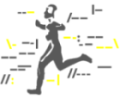





Search | Sitemap | Navigation |  |
|
||||||||||||||||||||||||||
|
||||||||||||||||||||||||||
|
||||||||||||||||||||||||||
|
| Migraine and Music |
Migraine and Literature
Lewis Carroll (1832-1898)
"Did you know that the scene where Alice (in Wonderland) drinks the potions and gets bigger and smaller is supposed to be because the author suffered from migraines and was just describing his own sensations?"
(Starbug, Newsgroups: alt.support.headaches.migraine, February 3, 2000)
"Heh, I was always fascinated by that story. Dunno, somehow makes me feel better that a famous writer suffered from migraine but used his experiences for literary inspiration!" [more]
(Infrazone, Newsgroups: alt.support.headaches.migraine, February 8, 2000)
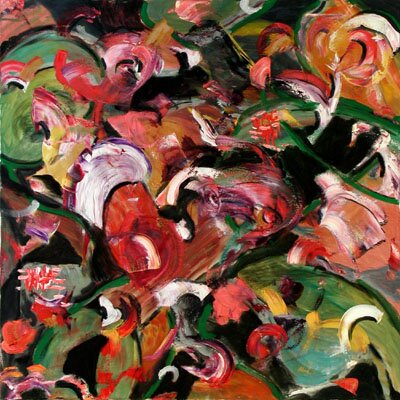
Ginger Royal, Beautiful Migraine, oil on canvas (36" x 36"), 1999. © 2005 Ginger Royal (http://www.gingerroyal.com/ dispWork.php?file= earlyworks&work=BeautifulMigraine, February 18, 2005)
madhuleema chaliha
"The bad part of a migraine is, without any doubt, the migraine itself. The good, and the most beautiful, part of it, however, is what happens to me after it has passed away. Unlike a medicine that leaves a bad taste in the mouth, a migraine almost always goes away leaving a strange feeling of wholeness inside my mind. It is the most destructive poison that I know of that contains within itself the seeds of regeneration." [more]
(madhuleema chaliha, The beauty of having a migraine..., June 28, 2003)
Margaret Cho
Korean American comedian, actress and political activist Margaret Cho, who made television history by being the first Asian American to have a television series (All American Girl) based around her, has published an account of her experiences as a migraine sufferer ("Migraine") in her daily weblog from June 16, 2004. [more]
Emily Dickinson (1830-1886)
"Emily Dickinson also wrote a poem about migraine which used as its metaphor coffin nails (very appropriate if you ask me)..... I am looking for it now..... Great Scot -- that Belle of Amherst wrote lots of poems!"
(Sharon Amabile, Newsgroups: alt.support.headaches.migraine, September 3, 2002)
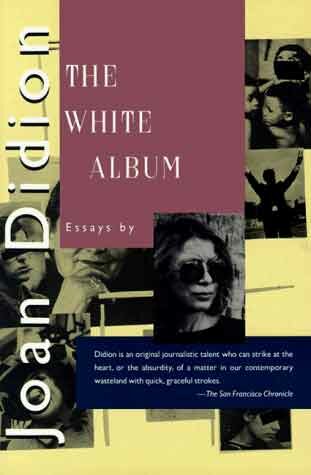
Joan Didion, The White Album, 1979. © 2004 Farrar, Straus, and Giroux, NewYork (www.culturevulture.net/Books2/whitealbum.jpg, October 6, 2004)
Joan Didion
"Anyone ever read the essay 'In Bed' [1979] by Joan Didion, on migraine? I found it six or seven years ago, and in it she pretty much characterizes her migraine as her enemy, which essentially attacks her, and about which she can do nothing."
(Jennifer K. Matesa, Newsgroups: alt.support.headaches.migraine, September 7, 1994)
"Years ago I read an essay by Joan Didion called 'In Bed' which was about her migraines, and she ended up by saying she'd come to accept them as something like 'a friend.' I thought that was ridiculous (though I very much liked the rest of the essay)." [more]
(Eva D. Struction, Newsgroups: alt.support.menopause, June 17, 1999)
Karla J. Dorman
In her poem "migraine" (2003), part time cashier / full time poet Karla J. Dorman from Burleson, Texas describes her visual migraine aura as "a jagged f l a s h of lightning", "zig zags", "shooting stars", "confetti in the air" - "has / the circus / come / to town"? [more]
Robert Flach
In his idea file entitled Migraine (2003), a fleshed out paragraph describing an idea for a poem or story, Robert Flach recorded a continuing dream that began with a false awakening and extended over several sleeping periods, which he recognized "as one of the most severe premonitions or auras of an approaching migraine" [more].
Jane Gwaltney
"It's a bunch of weird symptoms at the beginning of a migraine attack, also called an 'aura'. People have been known to experience vivid auditory and visual hallucinations just before it hits full force." "Hmmm..." Hank twirled a toothpick with his tongue. "Y'mean folks hear an' see things that ain't there?" [more]
(Jane Gwaltney, The Long and the Winding, 2002)
Jean Hanson
"In Hanson's essay, the reader is immediately pulled into the surreal world of a migraine headache sufferer."
(Stephanie Susnjara, About the Author - MIGRAINE - Jean Hanson author of "The Lightning in My Eyes", in: Lee Gutkind (ed.), A View from the Divide - Creative Nonfiction on Health and Science, Creative Nonfiction, issue 11, 2001)
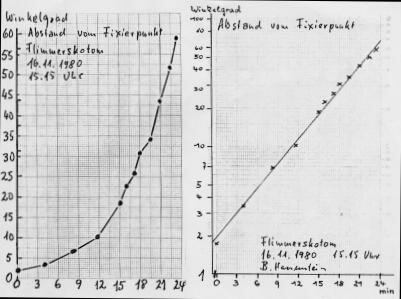
Bernhard Hassenstein, Measurement from personal episode of scintillating scotoma, November 16, 1980.
Bernhard Hassenstein
Bernhard Hassenstein, behavioral biologist and one of the founders of biological cybernetics, contributed an essay offering "Five variations about my migraine" (1981) to a volume in honor of his friend and publisher, Klaus Piper. In a both entertaining and informative way, he described his different approaches during lifetime to cope with his recurring experiences of scintillating scotomas, from a poem written as a 15-year-old to the systematic study of the phenomenon by the neuroscientist since his late 40s. [more]

Siri Hustvedt, The Blindfold, 1992. © 2004 W.W. Norton & Company, New York-London (http://images-eu.amazon.com/images/P/ 0393310132.01.LZZZZZZZ.jpg, July 25, 2004)
Siri Hustvedt
"But Hustvedt was an unusually sensitive child, who suffered from migraine, visual spots and lights, and even hallucinations, what she calls, 'my nerves and strangenesses'. She describes experiencing a Lilliputian hallucination [...] and has on occasion experienced euphoria just before a migraine attack. 'It gives the feeling of such fantastic wellbeing,' she whispers, 'that you can't believe it. It is wonderful, but this is a sort of brain trick. And I do think again that the whole idea of visual instability is very strong [...] and it's philosophical, but certainly someone who suffers from this might be more inclined to have that kind of view of the world - that we don't always know what we're looking at. How do we read the world? How do we interpret it?'"
(Cited from Article Darkness and Light © 2003 Telegraph Group Limited, November 10, 2003)
Erich Kästner (1899-1974)
His children book "Anna Louise and Anton" (1931) includes a definition of migraine which became a famous saying in Germany: "Migraine are headaches, even if you don't have any". Unfortunately, the aphorism is quoted more often to stigmatize migraine sufferers rather than to characterize the clinical type of migraine which is in fact characterized by a lack of cephalalgia, i.e., migraine aura without headache! [more]
Gyps Kindra
A 30-year-old female sufferer from definite persistent aura without infarction wrote a poem entitled "A billion stars" (2006) to describe her experience of enduring visual snow (vs). In her post to the Ezboard forum for those with visual snow and static, she recorded: "Someone here once asked if anyone has ever written poetry about our vs.... well I gave it a try" [more]
(Gyps Kindra, Ezboard forum Visual snow and static − Discussion − A billion stars, May 31, 2006)
Jukka Lehmus
"MIGRAINE DREAMS ... shedding bitter crimson into wintry city ... luminous bodies ... towering dawn ... February decay ... manifold mosaics ... malaise, nausea, diarrhoea, angled open ... move ... the open furnace ... ... ... angels shedding their shell-marble, shining material ... comet ... seminal similarity ... Christliness, throbbing chromosomes ... spiralling splinters ... white wings approaching. " (Jukka Lehmus, Cancer in Zenith) [more]
Jennifer K. Matesa
"I'm a writer, and I've found the opposite to be true for me. I often have my best story ideas while in bed in pain. My migraine seems to occupy, or preoccupy, a part of my mind that is usually taken up with self-criticism, self-censorship, stress, etc., allowing this other authoritative voice to speak. In effect, the migraine behaves as a circuit-breaker: when all that pressure gets too heavy, it interrupts the action so that authoritative part of me can function again, uninhibited. My goal recently has been to focus on letting that authority in me come out gradually, so there will be decreased need for the migraine to intervene." [more]
(Jennifer K. Matesa, Newsgroups: alt.support.headaches.migraine, September 7, 1994)
Marvin Minsky
In a contribution to a Usenet Newsgroups discussion from 1992, Marvin Minsky, the former director of the MIT Artificial Intelligence lab and considered to be one of the fathers of AI, recalled two episodes of autoscopy and scintillating scotoma experienced at the age of 17 and in his 20s, respectively. His previous reading of William James' Varieties of Religious Experience and Duke-Elder's Text-Book of Ophthalmology provided him with rational explanations of his weird hallucinations which can occur as visual migraine aura phenomena, so that he recommended to "make sure that your children learn about the 7 most common forms of mystical experience and whatever is known about their neurological mechanisms". "Of course", he added, "this is good advice only for those who like their minds the way they are." [more]
Friedrich Nietzsche (1844-1900)
"The perfect brightness and cheerfulness, even exuberance of spirit, that is reflected in the said work ['The Dawn'], is in my case compatible not only with the most profound physiological weakness, but also with an excess of pain. In the midst of the torments brought on by an uninterrupted three-day headache accompanied by the laborious vomiting of phlegm, - I possessed a dialectician's clarity par excellence, and in utter cold blood I then thought out things, for which when I am in better health I am not enough of a climber, not refined, not cold enough." [more]
(Friedrich Nietzsche, Ecce Homo - How one becomes what one is, Why I am So Wise, 1888, www.geocities.com/thenietzschechannel/eh3.htm, March 26, 2004)
Linda Pastan
Linda Pastan's poem "Migraine" (1995) from her volume "An Early Afterlife" is a descriptive portrait of what a migraineur suffers ("Ambushed by / pins and needles of light ...") and would give for an attack to end ("every blessing -- these shooting / stars ... the future ..."). [more]
Danielle Pafunda
"Migraine Trails a Dull Nude" (2003) is one of four poems by Danielle Pafunda, selected by David Lehman for publication in the journal Pleiades. Danielle Pafunda lives and writes in Athens, Georgia. She is co-Editor of the online journal La Petite Zine. [more]
Jenny Povey
Jenny Povey's Gryphon #1 (1996), posted as her first venture into the field of comic writing at a fanfiction newsgroup, refers to the characters and settings of the SteelWolfe® universe. The story exploits the ambiguities between the symptoms of visual migraine aura and the allegedly paranormal phenomenon of "seeing auras" - which may be, at least in some cases, one and the same? [more]
Oliver Sacks
"So I think one must infer, and there are few direct observations to suggest that in this creative unconscious, which is not the Freudian unconscious, nor is it the sort of physiological unconscious, but it's a special form of cognitive or creative unconscious, there must be innumerable fragments, ideas, impressions, feelings which are playing together, dancing, colliding, meeting, separating. But, I think sometimes in a delirium - I'm sure all of you have had a delirium once in while. I often have, I rather like them actually. Sometimes with migraine you have a delirium, or in fever; and then I think again sometimes you can feel this crowd of ideas and thoughts and images, rising up and coupling, but not getting anywhere. Whereas in a dream, or in a creative reverie, or in the creative unconscious, there is always some organising principle which is emerging and sort of, coagulating the ideas." [more]
(Cited from Oliver Sacks, Creativity, Imagination and Perception, Inaugural lecture given at the Centre for the Mind, Australian Academy of Science, Canberra, 1998)
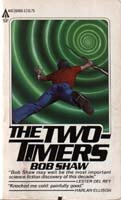
Bob Shaw, The Two-Timers, 1968. © 2004 Ace Books, New York (http://people.uncw.edu/smithms/Ace singles/sH-series/H-079.jpg, December 12, 2002)
Bob Shaw (1931-1996)
"The migraine-induced visual disturbances which I'd found so fascinating in The Two-Timers were part of routine existence for Bob, who went through this subjective light-show (hemicrania sine dolore) about twice a year. I've never been so grateful to Bob Shaw and to sf in general as when in the late 80s I started getting it myself, and was saved from abject panic by realizing this was the harmless phenomenon about which he'd been writing."
(Dave Langford, Wreath of Stars, September 10, 2003)
Sickan
"When the darkness comes" (2002) - a migraine sufferer's piece of prose describing the symptoms of an attack of basilar-type migraine. [more]
H.G. Wells (1866-1946)
"I have a tendency to read things in books and say 'ah! that writer must be describing a migraine.' ... Anyway, there are a couple of passages in H.G. Wells that I've always thought were descriptions of migraine prodromes. In 'The Remarkable Case of Davidson's Eyes', a man whose vision has somehow been warped by a strong magnetic field sees scenes that take place in a remote location. 'From that time Davidson began to mend. Over patches of his vision, the phantom would grew fainter, grew transparent as it were, and through these translucent gaps he began to see dimly the real world about him. The patches grew in size and number, ran together spread until only here and there were blind spots left upon his eyes...'"
(Daniel P.B. Smith, Newsgroups: sci.med.vision, Subject: vision during migraines, July 6, 1995)
References
Adler CS, Adler SM, Friedman AP. A historical perspective on psychiatric thinking about headache. In: Adler CS, Adler SM, Packard RC (eds) Psychiatric aspects of headache. Williams and Wilkins, Baltimore 1987, p. 3-21.
Alvarez WC. Notes on the history of migraine. Headache 1963; 11: 209-213.
Critchley M. Migraine: From Cappadocia to Queen Square. In: Smith R (ed) Background to Migraine. First Migraine Symposium 8th - 9th November 1966. William Heinemann Medical Books Ltd, London 1967, p. 28-38.
Engelhardt D v. Migräne in Medizin- und Kulturgeschichte. Pharmazie in unserer Zeit 2002; 31: 444-451.
Friedman AP. The headache in history, literature and legend. Bull NY Acad Med 1972; 48: 661-681.
Patterson SM, Silberstein SD. Sometimes Jello helps: Perceptions of headache etiology, triggers and treatment in literature. Headache 1993; 33: 76-81.
Sacks O. Creativity, Imagination and Perception. [Excerpts from a lecture by the same title, given at the Centre for the Mind, Australian Academy of Science, Canberra.]. In: Wilson S (ed) The Bloomsbury Book of the Mind. Bloomsbury, London 2003, pp. 29-32.
Wenzel M. Migräne. Die kleine Hölle. Zur Symptomatik und Therapie der Migräne in der Medizingeschichte. Insel, Frankfurt a.M. 1995.
Author: Klaus Podoll
Last modification of this page: Thursday March 17. 2005
| Migraine and Music |
 Top of the page
Top of the page| · | News |
| · | Medical Professionals |
| · | Medical Studies |
| · | The Migraine Art Concept |
| · | Migraine and Painting |
| · | Migraine and Music |
| · | |
Copyright © 2005 Migraine Aura Foundation, All rights reserved. Last modification of this site: August 25, 2006
Thanks to: RAFFELT MEDIENDESIGN and GNU software | webmaster@migraine-aura.org
http://migraine-aura.org/EN/Migraine_and_Literature.html
